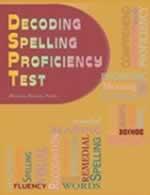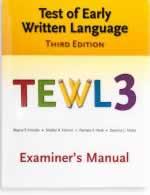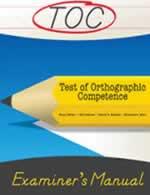TOC: Test of Orthographic Competence
Interest Level:
Additional Components:
Test, Manual, Pictire Book, Record Forms and Response Bppklets
At last! A comprehensive standardized measure of orthographic skills! Testing Time: 30-45 minutes Administration: Individual or Group The Test of Orthographic Competence (TOC) assesses aspects of the English writing system that are integral to proficient reading and writing. These aspects include letters, spelling, punctuation, abbreviations, and special symbols. The TOC has three age-related forms (6-7 years, 8-12 years, and 13-17 years). Normed on a national representative sample...
At last! A comprehensive standardized measure of orthographic skills!
Testing Time: 30-45 minutes
Administration: Individual or Group
Subtests
The TOC has nine subtests, which vary by age-level. The form for ages 6-7 years is comprised of Signs and Symbols, Grapheme Matching, Homophone Choice, and Punctuation. The form for ages 8-12 years is comprised of Homophone Choice, Punctuation, Abbreviations, Letter Choice Word Scramble, and Sight Spelling. The form for ages 13-17 years is comprised of Punctuation, Abbreviations, Letter Choice, Word Scramble, Sight Spelling, and Word Choice. A description of the subtests follows.
- Signs and Symbols. The child looks at a series of printed signs and symbols such as a “club” from a deck of cards, an “equal” or a “dollar” sign, or a numeral “5.” The child is asked to tell the examiner what each sign signifies.
- Grapheme Matching. The child is shown a series of rows each of which has five figures. The figures can be objects, signs, letters, or group of letters (e.g., b e o l e). In each row, two of the five figures are identical. The child is to identify the two identical figures in each row by making a slash through them. The child is given two minutes to complete as many rows as possible.
- Homophone Choice. Students look at a picture with two or three possible spellings choices (e.g., a picture of a boat oar with the spelling choices of oar, ore, and or). The students then circle the word they think is the correct spelling for the picture in each row.
- Punctuation. The student is given a list of printed sentences that contain no punctuation except for spacing between the words (e.g., where is edward b brown). The task is for the student to supply the missing punctuation by editing the sentence.
- Abbreviations. The examiner points to one of several abbreviations printed on a page (e.g., 4:00, Dr., USA) and asks the student to tell or write (depending on which version is given) what the particular abbreviation means.
- Letter Choice. The student is shown rows of words where one of four letters (p, d, b, or q) is missing from the word (e.g., _etter where the letter b is missing from the word or sai_ where the letter d is missing from the word). The student is given two minutes to write in the correct letters that will make each one into a real word.
- Word Scramble. The student is shown sets of scrambled letters that can be rearranged to spell real words (e.g., the letters nra can be rearranged to spell the word ran). The student has three minutes to re-order as many groups of letters into words as possible within the time frame.
- Sight Spelling. The examiner says a word and the student is shown part of the word where one or more of the letters is missing (e.g., the examiner says the word know and student sees ___ow.) The student is asked to fill in the missing letter or letters to complete the spelling of the word.
- Word Choice. The examiner says a word and the student looks at three possible phonically regular spellings choices (e.g., sitty, sitee, city). The student then circles what he or she thinks is the correct spelling of the word in each row.
Composites
The results of the subtests on each version can be combined to form an overall composite. This composite is called Orthographic Ability (OA). The results from the 8-12 and 13-18- year-old forms can be combined to create three additional orthographic composites: Conventions (CO), Spelling Accuracy (SA), and Spelling Fluency (SF).
Technical Characteristics
The TOC evidences a very high degree of reliability across all three types of reliability (coefficient alpha, test-retest, and scorer differences). Alphas for the composites range from .90 to .98 and from .81 to .97 for the subtests. TOC also possesses strong content-description, criterion-prediction, and construct-identification validity indicating it can be used with confidence. The Orthographic Ability Index correlates in the .70s with 10 popular measures of reading and writing.
COMPLETE TOC (©2008) KIT INCLUDES:
- Examiner's Manual
- Picture Book (Ages 6-7)
- 25 Examiner Record Forms (Ages 6-7)
- 25 Student Response Booklets (Ages 6-7)
- 25 Student Response Booklets (Ages 8-12)
- 25 Student Response Booklets (Ages 13-17)
- all in a sturdy storage box.
User Qualifications:
“All test users, regardless of level and profession, are expected to abide by the standards set forth by the APA, AERA and NCME regarding the ethical use, protection and dissemination of all test materials.
All orders for the products listed below cannot be completed online, they must be placed on official institutional purchase order forms or professional letterhead. For questions or help placing your order for these items call (800) 880-4433.
Item #
Products
Price
Wishlist
Qty
Requested quantity is not available at this time
YP1962YT
TOC: Examiner Record Forms Ages 6-7
$42.00
Requested quantity is not available at this time
YP1965YT
TOC: Student Response Booklets (Ages 13-17)
$82.00
Requested quantity is not available at this time
YP1966YT
TOC: Student Response Booklets (Ages 6-7)
$73.00
Requested quantity is not available at this time
YP1967YT
TOC: Student Response Booklets (Ages 8-12)
$82.00




